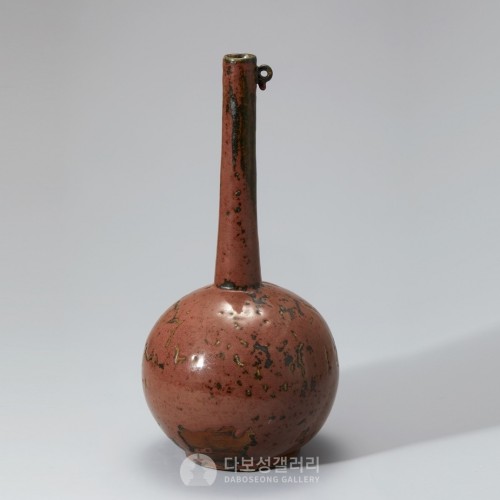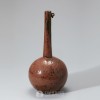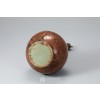본문
동그란 몸통에 긴 목과 좁은 구연부를 지닌 장경병(長頸甁)입니다. 가늘고 긴 목에 통통한 둥근 몸통을 가진 이러한 병을 일본에서는 학의 목을 닮았다고 하여 학목병이라고 부르기도 합니다.
이 병은 몸체에 청자 유약을 바르고 다시 그 표면에 적색 안료인 산화동을 시유하였습니다. 굽 바닥 부분은 적색 안료가 시유되지 않아 푸른 청자 유약이 그대로 남아 있으며, 고온에서 잘 견디는 내화토(耐火土)를 받쳐 구운 흔적이 있습니다.
이 청자 진사채 장경병은 고려시대 황실이나 귀족이 사용했던 것으로 예상되며 이와 비슷한 형태의 고려시대 유물이 일본 오사카 동양 도자 미술관에도 소장되어 있어 귀중한 유물로 평가됩니다.
━━━━━
该长颈瓶身圆,长颈,窄口沿。这种细长颈和圆腹的组成,因为长得像鹤的脖子,所以在日本也被称为鹤颈瓶。该瓶体施青瓷釉,再在其表面施用红色氧化铜颜料。底足无釉,保留蓝色的青瓷釉,有用耐高温的耐火土支撑烧制的痕迹。据推测,该青瓷真丝彩长颈瓶供高丽时代的皇室或贵族使用,与此相似形态的高丽时代遗物也收藏在日本大阪东洋陶瓷美术馆,因此被评价为珍贵的遗物。
━━━━━
This is a Janggyeongbyeong (long-neck vase) with a globular body, cylindrical neck, and narrow mouth. This kind of vase is also called Hakmokbyeong in Japan because it resembles a crane's neck. The surface was painted in celadon glaze and then again applied copper oxide, a kind of red pigment. The base is not glazed, revealing the blue color of celadon. It also has a trace of being baked on soil that can withstand high temperatures. This work is expected to have been used by the royal family or aristocrats during the Goryeo Dynasty. A similar Goryeo Dynasty relic is also held in the Museum of Oriental Ceramics in Osaka, Japan.


